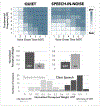Speech Perception is Speech Learning
- PMID: 40822618
- PMCID: PMC12355217
- DOI: 10.1177/09637214251318726
Speech Perception is Speech Learning
Abstract
Speech conveys both linguistic messages and a wealth of social and identity information about a talker. This information arrives as complex variation across many acoustic dimensions. Ultimately, speech communication depends upon experience within a language community to develop shared long-term knowledge of the mapping from acoustic patterns to the category distinctions that support word recognition, emotion evaluation, and talker identification. A great deal of research has focused on the learning involved in acquiring long-term knowledge to support speech categorization. Inadvertently, this focus may give the impression of a mature learning endpoint. Instead, there seems to be no firm line between perception and learning in speech. The contributions of acoustic dimensions are malleably reweighted continuously as a function of regularities evolving in short term input. In this way, continuous learning across speech impacts the very nature of the mapping from sensory input to perceived category. Broadly, this presents a case study in understanding how incoming sensory input - and the learning that takes place across it -- interacts with existing knowledge to drive predictions that tune the system to support future behavior.
Keywords: Categorization; Perceptual Weights; Speech Perception; Statistical Learning.
Figures


Similar articles
-
Short-Term Memory Impairment.2024 Jun 8. In: StatPearls [Internet]. Treasure Island (FL): StatPearls Publishing; 2025 Jan–. 2024 Jun 8. In: StatPearls [Internet]. Treasure Island (FL): StatPearls Publishing; 2025 Jan–. PMID: 31424720 Free Books & Documents.
-
Prescription of Controlled Substances: Benefits and Risks.2025 Jul 6. In: StatPearls [Internet]. Treasure Island (FL): StatPearls Publishing; 2025 Jan–. 2025 Jul 6. In: StatPearls [Internet]. Treasure Island (FL): StatPearls Publishing; 2025 Jan–. PMID: 30726003 Free Books & Documents.
-
Neonatal Nurses' Understanding of the Factors That Enhance and Hinder Early Communication Between Preterm Infants and Their Parents: A Narrative Inquiry Study.Int J Lang Commun Disord. 2025 Jul-Aug;60(4):e70093. doi: 10.1111/1460-6984.70093. Int J Lang Commun Disord. 2025. PMID: 40653954 Free PMC article.
-
A systematic review of speech, language and communication interventions for children with Down syndrome from 0 to 6 years.Int J Lang Commun Disord. 2022 Mar;57(2):441-463. doi: 10.1111/1460-6984.12699. Epub 2022 Feb 22. Int J Lang Commun Disord. 2022. PMID: 35191587
-
The Black Book of Psychotropic Dosing and Monitoring.Psychopharmacol Bull. 2024 Jul 8;54(3):8-59. Psychopharmacol Bull. 2024. PMID: 38993656 Free PMC article. Review.
References
-
- Bernstein LE (1983). Perceptual development for labeling words varying in voice onset time and fundamental frequency. Journal of Phonetics, 11, 383–393.
-
- Blumstein SE & Stevens KN (1981). Phonetic features and acoustic invariance in speech. Cognition, 10, 25–32. - PubMed
-
- Escudero P, & Boersma P (2004). Bridging the gap between L2 speech perception research and phonological theory. Studies in Second Language Acquisition, 26, 551–585.
Grants and funding
LinkOut - more resources
Full Text Sources
